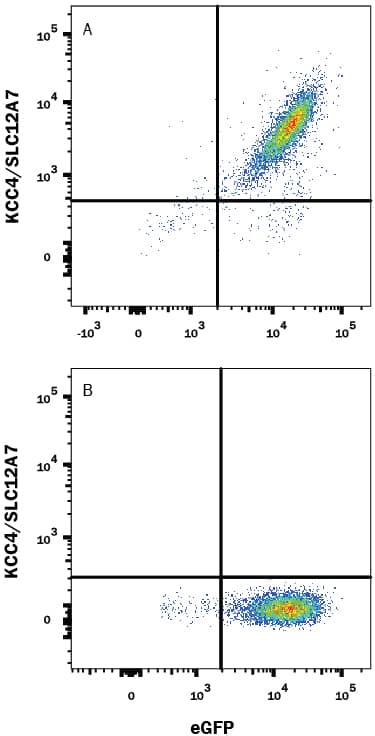Human KCC4/SLC12A7 Alexa Fluor® 647-conjugated Antibody
R&D Systems, part of Bio-Techne | Catalog # FAB9030R


Key Product Details
Species Reactivity
Applications
Label
Antibody Source
Product Specifications
Immunogen
Met1-Ser1083
Accession # Q9Y666
Specificity
Clonality
Host
Isotype
Scientific Data Images for Human KCC4/SLC12A7 Alexa Fluor® 647-conjugated Antibody
Detection of KCC4/SLC12A7 in HEK293 Human Cell Line Transfected with Human SLC12A7 and eGFP by Flow Cytometry.
HEK293 human embryonic kidney cell line transfected with either (A) human SLC12A7 or (B) irrelevant transfectants and eGFP was stained with Mouse Anti-Human KCC4/SLC12A7 Alexa Fluor® 647-conjugated Monoclonal Antibody (Catalog # FAB9030R). Quadrant markers were set based on control antibody staining (Catalog # IC002R). View our protocol for Staining Membrane-associated Proteins.Applications for Human KCC4/SLC12A7 Alexa Fluor® 647-conjugated Antibody
Flow Cytometry
Sample: HEK293 human embryonic kidney cell line transfected with human KCC4/SLC12A7 and eGFP
Formulation, Preparation, and Storage
Purification
Formulation
Shipping
Stability & Storage
- 12 months from date of receipt, 2 to 8 °C as supplied.
Background: KCC4/SLC12A7
KCC4 (Potassium Chloride Cotransporter 4), also known as SLC12A7, is a 130-145 kDa member of the SLC12A family of ion transporter molecules. It is a 12-transmembrane, 1083 amino acid (aa), variably glycosylated protein that basically serves three functions: one, it acts as a membrane-bound scaffold for Ezrin-associated cytoskeletal organization; two, it is involved in salt resorption; and three, while inactive under isotonic conditions, it is activated during cell swelling, reducing intracellular ion concentration with a subsequent reduction in cell volume. On the cell surface, KCC4 presents as either a homooligomer, or a heterooligomer in a complex with KCC2 or NKCC1. Cell known to express KCC4 include PNS neurons, select CNS neurons, choroid plexus epithelium, proximal convoluted tubule and thick ascending loop of Henle epithelium, pancreatic islet alpha-cells, gastric parietal cells, alpha-intercalated cells of the renal collecting duct, and erythrocytes. The extracellular domains of human mouse KCC4 share 85% aa sequence identity.
Long Name
Alternate Names
Gene Symbol
UniProt
Additional KCC4/SLC12A7 Products
Product Specific Notices for Human KCC4/SLC12A7 Alexa Fluor® 647-conjugated Antibody
This product is provided under an agreement between Life Technologies Corporation and R&D Systems, Inc, and the manufacture, use, sale or import of this product is subject to one or more US patents and corresponding non-US equivalents, owned by Life Technologies Corporation and its affiliates. The purchase of this product conveys to the buyer the non-transferable right to use the purchased amount of the product and components of the product only in research conducted by the buyer (whether the buyer is an academic or for-profit entity). The sale of this product is expressly conditioned on the buyer not using the product or its components (1) in manufacturing; (2) to provide a service, information, or data to an unaffiliated third party for payment; (3) for therapeutic, diagnostic or prophylactic purposes; (4) to resell, sell, or otherwise transfer this product or its components to any third party, or for any other commercial purpose. Life Technologies Corporation will not assert a claim against the buyer of the infringement of the above patents based on the manufacture, use or sale of a commercial product developed in research by the buyer in which this product or its components was employed, provided that neither this product nor any of its components was used in the manufacture of such product. For information on purchasing a license to this product for purposes other than research, contact Life Technologies Corporation, Cell Analysis Business Unit, Business Development, 29851 Willow Creek Road, Eugene, OR 97402, Tel: (541) 465-8300. Fax: (541) 335-0354.
For research use only